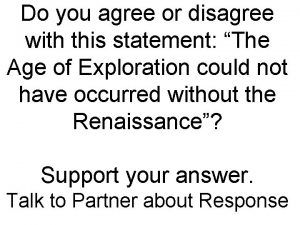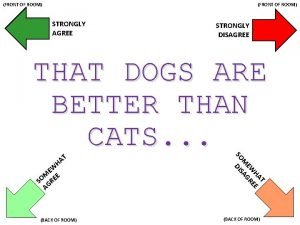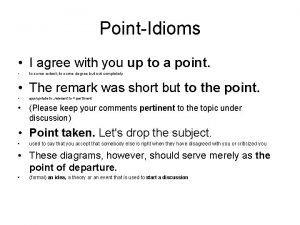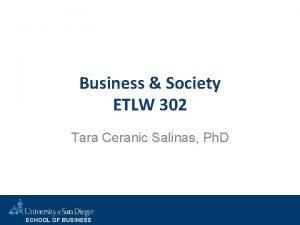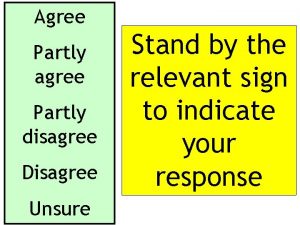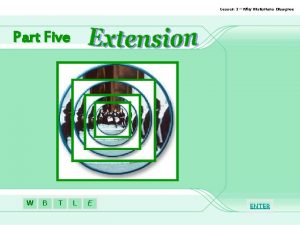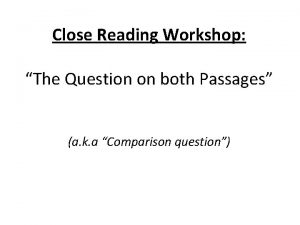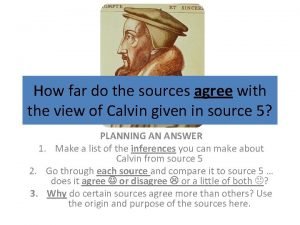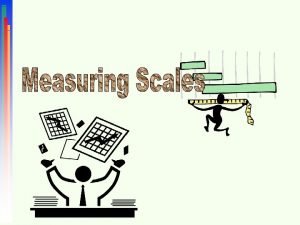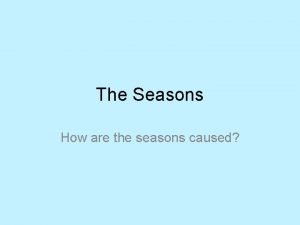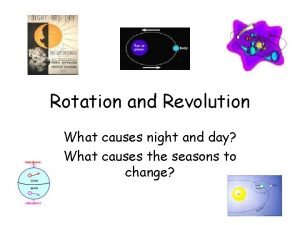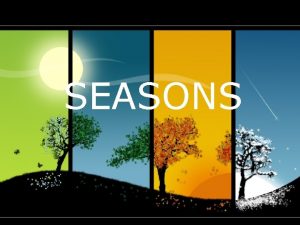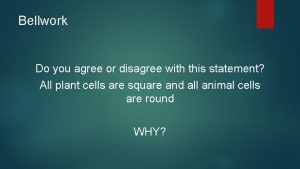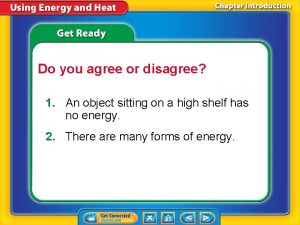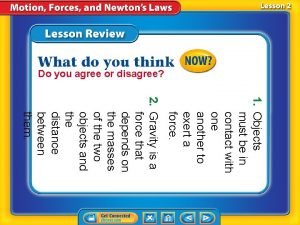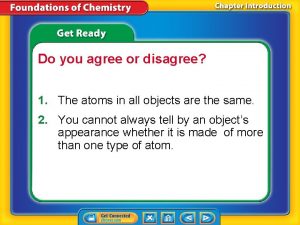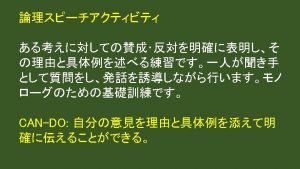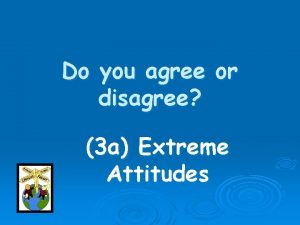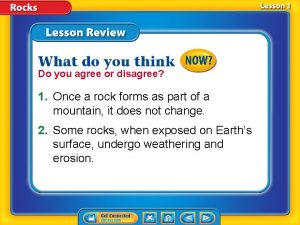Do you agree or disagree 1 Seasons are




















































- Slides: 52

Do you agree or disagree? 1. Seasons are caused by the changing distance between Earth and the Sun. 2. The Moon has a dark side upon which the Sun never shines. 3. The solar system contains nine planets. 4. Earth is the only planet that has a moon.

Do you agree or disagree? 5. The Sun is more massive than 90 percent of other stars. 6. The solar system is at the center of the Milky Way.

The Sun-Earth-Moon System • revolution • waning • rotation • tide • equinox • eclipse • solstice • waxing

Earth and the Universe • Earth is one of eight planets that orbit the Sun. • The Sun is one of billions of stars that make up the Milky Way galaxy. • The Milky Way is one of billions of galaxies in the universe.

The Sun is 100 times wider than Earth and 10 times wider than the planet Jupiter. The Sun and Jupiter are the two largest objects in the solar system.

Motions of Earth (cont. ) The orbit of an object around another object is revolution. Jason Reed/Getty Images

Motions of Earth (cont. ) • Rotation is the spin of an object around its axis. • Earth spins, or rotates, on its axis like a top.

Motions of Earth (cont. ) • Earth’s rotation causes day and night.

Earth’s Tilt and Seasons occur because Earth’s tilt does not change as Earth orbits the Sun.

• When the North Pole is toward the Sun, it is summer in the northern hemisphere. • When the South Pole is toward the Sun, it is winter in the northern hemisphere.

Earth’s Moon (cont. ) • The Moon is visible because it reflects sunlight. • The Moon completes a cycle of phases every 29. 5 days.

Tides • Tides are the periodic rise and fall of the oceans’ surfaces caused by the gravitational force between Earth and the Moon and the Sun. • The Moon has more influence on tides than the Sun because it is closer to Earth than the Sun.

Tides (cont. ) • High tides on Earth occur at locations closest to and farthest from the Moon. • Most coastlines have two high tides and two low tides each day.

• During a solar eclipse, a small part of Earth is in the Moon’s shadow. • The Moon appears to completely or partially cover the Sun.

• During a lunar eclipse, Earth’s shadow completely or partially covers the Moon. • The Moon is visible during a total lunar eclipse because light changes direction as it passes through Earth’s atmosphere.

How long does it take Earth to revolve once around the Sun? A. 5 years B. 6 months C. 24 hours D. 365. 25 days

A lunar eclipse occurs during which type of moon? A. full moon B. new moon C. waning moon D. waxing moon

The Solar System • planet • comet • dwarf planet • meteoroid • moon • meteor • asteroid



The Solar System (cont. ) What objects are in the solar system?

• The four inner planets formed from rocks and heavy elements left behind from the creation of the solar system. • The cores of the inner planets are mostly iron. Mercury: NASA/Johns Hopkins University Applied Physics Laboratory/Carnegie Institution of Washington; Venus: NASA; Earth: NASA Goddard Space Flight Center; Mars: NASA/JPL/Malin Space Science Systems

• The inner planets are the smallest planets. • They have few or no moons, no rings, and they rotate more slowly than the outer planets. Mercury: NASA/Johns Hopkins University Applied Physics Laboratory/Carnegie Institution of Washington; Venus: NASA; Earth: NASA Goddard Space Flight Center; Mars: NASA/JPL/Malin Space Science Systems

• The four outermost planets formed farther from the Sun than the inner planets did. • They have more gases and other materials with low boiling points and are often called the gas giants. Earth: NASA Goddard Space Flight Center; Jupiter: NASA/JPL/USGS; Saturn: NASA and The Hubble Heritage Team (STSc. I/AURA)Acknowledgment: R. G. French (Wellesley College), J. Cuzzi (NASA/Ames), L. Dones (Sw. RI), and J. ; Uranus, Neptune: NASA/JPL

• They are larger than the inner planets, they rotate more quickly, and they each have rings. • These planets do not have solid surfaces. They have thick atmospheres of hydrogen and helium. Earth: NASA Goddard Space Flight Center; Jupiter: NASA/JPL/USGS; Saturn: NASA and The Hubble Heritage Team (STSc. I/AURA)Acknowledgment: R. G. French (Wellesley College), J. Cuzzi (NASA/Ames), L. Dones (Sw. RI), and J. ; Uranus, Neptune: NASA/JPL

The Solar System (cont. ) How do the inner and outer planets differ?

Stars, Galaxies, and the Universe • star • light-year • galaxy • Big Bang theory

Stars A star is a large sphere of hydrogen gas hot enough for nuclear reactions to occur in its core.

Stars (cont. ) • When measuring distances to stars, astronomers use a unit of distance based on the speed of light. • A light-year is the distance light travels in one year. Light travels 300, 000 km/s. One light-year equals 9. 46 trillion km.

Stars (cont. ) The color of a star indicates its temperature.

Stars (cont. ) Blue stars are the hottest stars, followed by blue-white, yellow, orange, and red stars. The Sun is a yellow star.

Stars (cont. ) The Sun is larger and more massive than 90 percent of other stars but is still tiny compared to the some giant stars.

Stars (cont. ) • The Sun will continue to shine for another 5 billion years. • Then it will became a small, dense, white dwarf star. SOHO (ESA & NASA)

Stars (cont. ) How does the Sun compare in size to other stars?

Stars (cont. ) • In a binary star system, two stars orbit each other’s center of mass. • In a multiple-star system, two or more stars orbit the entire system’s center of mass.

Galaxies • A galaxy is a huge collection of stars, gas, and dust. • Astronomers classify galaxies by their shapes. Irregular galaxy NASA/JPL-Caltech/S. Willner (Harvard-Smithsonian Center for Astrophysics) Local Group Galaxies Survey Team, NOAO, AURA, NSF JPL/NASA Elliptical galaxy Spiral galaxy

The Universe • Most galaxies are pulled by gravity into clusters of galaxies. • The Milky Way is part of a cluster called the Local Group, which contains about 30 galaxies. • Superclusters are some of the largest structures in the universe and may contain thousands of galaxies.

The Universe (cont. ) How is the universe structured?

The Universe (cont. ) The Big Bang theory states that the universe began from one point and has been expanding and cooling ever since. Photodisc/Getty Images

Which is the distance light travels in one year? A. astronomical unit B. galaxy C. light year D. supercluster

Astronomers classify galaxies by which of these? A. color B. density C. shape D. size

Which type of star system has two or more stars that orbit the entire system’s center of mass? A. binary B. elliptical C. irregular D. multiple

Do you agree or disagree? 5. The Sun is more massive than 90 percent of other stars. 6. The solar system is at the center of the Milky Way.

How long does it take the Earth to make one full rotation? A. 24 hours B. 6 months C. 365. 25 days D. 5 years

Which term describes small, rocky objects that orbit the Sun? A. moons B. dwarf planets C. comets D. asteroids

When a meteoroid impacts the Earth, what does it become? A. meteorite B. meteor C. comet D. asteroid

Which term refers to a huge collection of stars, gas, and dust? A. galaxy B. light year C. solar system D. universe

Which describes the spin of an object around its axis? A. orbit B. revolution C. rotation D. solstice

Which occurs when Earth’s rotation axis is tilted neither toward nor away from the Sun? A. eclipse B. equinox C. solstice D. tides

Which is a natural satellite that orbits an object other than a star? A. dwarf planet B. meteoroid C. moon D. planet

Which describes the streak of light produced when a meteoroid enters Earth’s atmosphere? A. asteroid B. comet C. meteor D. meteorite

Which is a large sphere of hydrogen gas hot enough for nuclear reactions to occur in its core? A. star B. planet C. light-year D. galaxy
 You are what you eat do you agree or disagree
You are what you eat do you agree or disagree Do you agree or disagree with the statement
Do you agree or disagree with the statement Do you agree or disagree with the statement
Do you agree or disagree with the statement Insidan region jh
Insidan region jh Mistakes are the portals of discovery agree or disagree
Mistakes are the portals of discovery agree or disagree Agree disagree line
Agree disagree line Agree strongly agree
Agree strongly agree Haven vs wilderness examples
Haven vs wilderness examples How far do you agree
How far do you agree I agree up to a point
I agree up to a point Love begets love do you agree
Love begets love do you agree How strongly do you agree with the following statement
How strongly do you agree with the following statement Dare to disagree socrates
Dare to disagree socrates Partly agree
Partly agree Why historians disagree
Why historians disagree Plural verbs
Plural verbs Draw an arrow from the pronoun to its antecedent
Draw an arrow from the pronoun to its antecedent The author of both passages agree that
The author of both passages agree that Positive negative agreement
Positive negative agreement Dominios agree ii
Dominios agree ii Make verbs agree after expressions of quantity
Make verbs agree after expressions of quantity Agree build challenge questioning
Agree build challenge questioning Most historians agree that military disasters
Most historians agree that military disasters Dgac visite médicale classe 1
Dgac visite médicale classe 1 Noun to agree
Noun to agree Agree passive voice
Agree passive voice Identify a key term used in both passages.
Identify a key term used in both passages. Which city does romeo go after being exiled from verona
Which city does romeo go after being exiled from verona Seem verb pattern
Seem verb pattern How far do the sources agree
How far do the sources agree Replace 3. hali
Replace 3. hali Agree present tense
Agree present tense Verb noun agreement
Verb noun agreement In your notebook write how much it is
In your notebook write how much it is Itemized scale example
Itemized scale example What does curley wear on his head
What does curley wear on his head Why do we have seasons
Why do we have seasons Why do we experience seasons
Why do we experience seasons Seasons in czech republic
Seasons in czech republic How many seasons in a year
How many seasons in a year Fall is what months
Fall is what months The wire themes
The wire themes Why seasons
Why seasons Clove of the seasons
Clove of the seasons Seasons of liturgical year
Seasons of liturgical year S
S How do seasons work
How do seasons work Tongue twister spring
Tongue twister spring Seasons of the year in english
Seasons of the year in english The correct order of the seasons
The correct order of the seasons Months in fall
Months in fall What causes day and night rotation or revolution
What causes day and night rotation or revolution True or false questions about seasons
True or false questions about seasons

